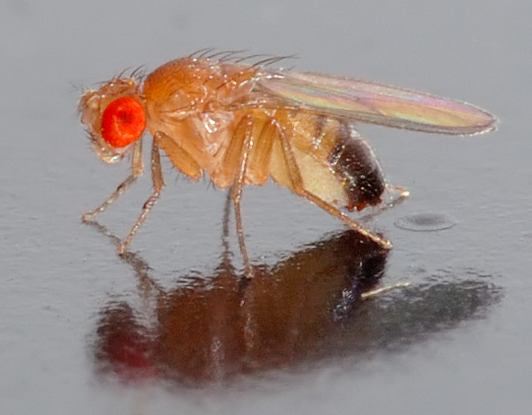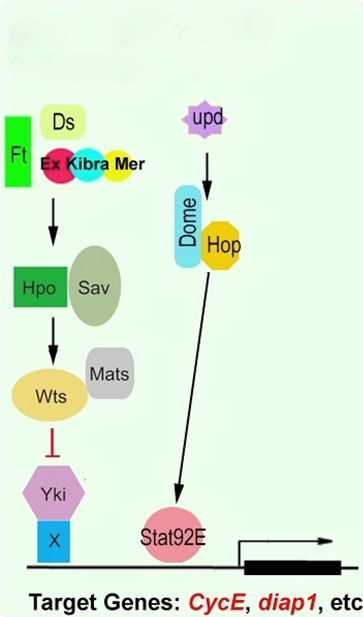|
Lijuan Du is a senior PhD. student in the Department of Entomology at the University of Maryland in College Park, MD. Having completed her bachelor’s degree in bioengineering at the prestigious Shanghai Jiaotong University in China, she began her graduate work in 2009 under the supervision of Dr. Jian Wang, whose lab specializes in using Drosophila as a model organism in the field of genetics. The fruit fly, Drosophila melanogaster, has been a model organism for over one hundred years to study genetics and developmental biology. Countless researchers work with it, and an impressively large amount of data has been accumulated thanks this work. It has been a successful model organism for many reasons. It is small, has a simple and easily produced diet, and has a short life cycle which allows many generations to be produced in a short period of time. There are mutants available for a large number of genes, and new mutations can be induced very easily. It also has a small, compact genome of only 165 million base pairs in length, containing about 14,000 genes. One of the most interesting things about D. melanogaster is that it has orthologs to about 62% of human disease genes allowing it to serve as model for the study of many biomedical processes. Neuronal morphogenesis is studied by working with D. melanogaster’s mushroom bodies (centers similar to the hippocampus in the human brain), centers for olfactory mediated learning and memory. Within the mushroom bodies there are 3 major classes of intrinsic neurons (γ, α’/β’, and α/β neurons) distinguished by morphological characteristics as well as by birth order during development (Crittenden et al., 1998). By performing a forward genetic screen, Lijuan found that the loss of JAK/STAT signaling receptor dome function in the neurons causes a gamma- only phenotype in adult fly mushroom bodies, and Lijuan further confirmed that the loss of JAK/STAT pathway (important for growth and development) signaling was the cause of the gamma-only phenotype. She showed that the loss of dome does not affect the morphology, remodeling or survival of gamma-neurons in the mushroom bodies. She also showed that JAK/STAT signaling promotes cell division and prevents premature termination of the mushroom body neuroblasts. In order to identify potential downstream targets of the JAK/STAT pathway, a reverse genetic screening was done to see which genes were able to rescue mutants which lacked the proper expression of dome. A total of 3 genes were identified from this screen, namely diap, yorkie and cycE. To provide further evidence for cycE as a putative downstream target, Lijuan carried out a transgenic injection, the inserted DNA having a STAT-binding site within the isolated cycE gene. The transgenic analysis confirmed that the proposed binding site within the cycE gene was indeed a STAT binding site. JAK/STAT signaling directly regulate cycE transcription in wing discs and in mushroom bodies. After this part of the experiment the function of a gene called yorkie in mushroom bodies was investigated. In together, Lijuan showed that loss of JAK/STAT and Hippo pathway downstream effector Yorkie cause similar cell proliferation defects, and higher activation of one can compensate for lack of the other. Eventually it was determined that Stat92E and Yorkie converge to regulatecycE gene expression via different cis-regulatory element. Chris Taylor is a PhD student with focal areas in IPM and insect-microbe symbioses. He studies the brown marmorated stink bug (BMSB), and the focus of his research is on understanding the relationship between BMSB and its gut symbionts to determine whether exploiting this relationship is feasible in management programs.
Justin Rosenthal received his undergraduate degree from the University of Maryland-College Park in 2011 in the Biological Sciences, with a concentration in neurobiology/physiology. Upon beginning his PhD. Program here, Justin began investigating the role of a particular gene, darkener of apricot(Doa), in promoting neuron survival through the pupal stage of insect life, i.e. metamorphosis. Building upon previous research, it became ever more convincing that without this gene certain neurons within a Drosophila’s brain will not survive until adulthood. Currently he is working out the purpose of specific exons and isoforms of this gene, as several variations exist. Further research will likely include expansion of this investigation into other non-nervous tissue. Overall this information will provide a molecular model for how cell death, especially in neurons, proceeds. Comments are closed.
|
Categories
All
Archives
June 2024
|
Department of Entomology
University of Maryland
4112 Plant Sciences Building
College Park, MD 20742-4454
USA
Telephone: 301.405.3911
Fax: 301.314.9290
University of Maryland
4112 Plant Sciences Building
College Park, MD 20742-4454
USA
Telephone: 301.405.3911
Fax: 301.314.9290




 RSS Feed
RSS Feed




